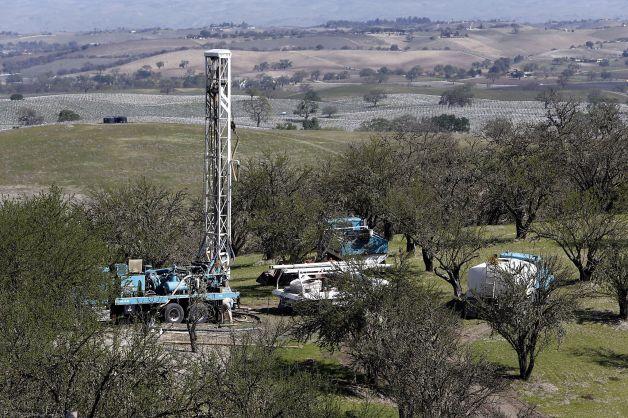
An analysis of data from NASA's Gravity Recovery and Climate Experiment (GRACE) Mission indicates the U.S. Southwest is more vulnerable to drought and water shortages than previously believed.
Studying 14 years of GRACE satellite data since late 2004 covering the parched Colorado River Basin, NASA and University of California, Irvine scientists found that groundwater loss accounts for more than 75 percent of total freshwater resource loss across the basin region.
Freshwater flowing through the Colorado River Basin is the lifeblood of cities and communities throughout the seven-state region and beyond into Mexico, supplying freshwater to 40 million people and irrigation for some 40 million acres of farmland in the southwestern U.S. However, the basin “has been suffering from prolonged, severe drought since 2000 and has experienced the driest 14-year period in the last 100 years,” NASA highlights in a news release.
Coping with drought
Results of NASA-UC Irvine's Colorado River Basin groundwater study – the first to quantify groundwater contributions to the basin's watershed – indicates “that groundwater loss may pose a greater threat to the water supply of the western United States than previously thought,” NASA states. That raises the stakes for farmers, factories and commercial businesses, as well as entire towns, cities and states throughout the region, as they try to conserve freshwater resources and identify and implement sustainable water resource management solutions.
Researchers at the University of California, Davis Center for Watershed Sciences peg the total economic cost of the ongoing drought in California's Central Valley – the state's agricultural heartland – at $1.7 billion.
Struggling to cope with severe or exceptional drought conditions, California farmers and ranchers have been drilling new water wells at a record pace, raising concerns about the sustainability of groundwater supplies.
Requests to drill new water wells “have soared, more than doubling over this time last year” in some counties, according to a Bakersfield Now online news report. The number of new requests for agricultural water-drilling permits in Kern County has more than quadrupled year over year.
The water lifeline of the western U.S.
Explaining the NASA-UC Irvine research team's motivation, report senior author Jay Famiglietti, a senior water cycle scientist at the U.S. Jet Propulsion Laboratory and a professor of Earth Sciences at UC Irvine, said:
"The Colorado River Basin is the water lifeline of the western United States. With Lake Mead at its lowest level ever, we wanted to explore whether the basin, like most other regions around the world, was relying on groundwater to make up for the limited surface-water supply. We found a surprisingly high and long-term reliance on groundwater to bridge the gap between supply and demand."
Changes in mass and gravity measured from space by the GRACE mission's twin satellites are related to changes in water on or below the surface, NASA explains. Studying monthly GRACE measurements from December 2004 through November 2013, the researchers found that the Colorado River Basin lost nearly 53 million acre feet (65 cubic kilometers) of freshwater over the period. That's nearly twice the volume of freshwater found in Nevada's Lake Mead, the largest freshwater reservoir in the U.S.
Groundwater loss represented more than 75 percent of the freshwater loss – some 41 million acre feet (50 cu km).
Shocking groundwater loss
Commenting on the surprisingly large amount of groundwater loss in the basin, Stephanie Castle, UC Irvine water resources specialist and study lead author, stated:
"We don't know exactly how much groundwater we have left, so we don't know when we're going to run out. This is a lot of water to lose. We thought that the picture could be pretty bad, but this was shocking."
The U.S. Bureau of Reclamation manages waters above ground in lakes and rivers throughout the Colorado River Basin and documents losses. Pumping from underground aquifers is regulated by states -- and often isn't, NASA notes.
"NASA's GRACE satellites provide researchers with a view of regional groundwater resources that otherwise would be unattainable," Famiglietti added. "There's only one way to put together a very large-area study like this, and that is with satellites. There's just not enough information available from well data to put together a consistent, basin-wide picture."
The researchers' findings compounds “the problem of short supply by leading to further declines in stream flow in the Colorado River,” NASA points out.
"Combined with declining snowpack and population growth, this will likely threaten the long-term ability of the basin to meet its water allocation commitments to the seven basin states and to Mexico," Famiglietti said.
*Image credits: 1), 3): NASA; 2) SFGate

An experienced, independent journalist, editor and researcher, Andrew has crisscrossed the globe while reporting on sustainability, corporate social responsibility, social and environmental entrepreneurship, renewable energy, energy efficiency and clean technology. He studied geology at CU, Boulder, has an MBA in finance from Pace University, and completed a certificate program in international governance for biodiversity at UN University in Japan.














